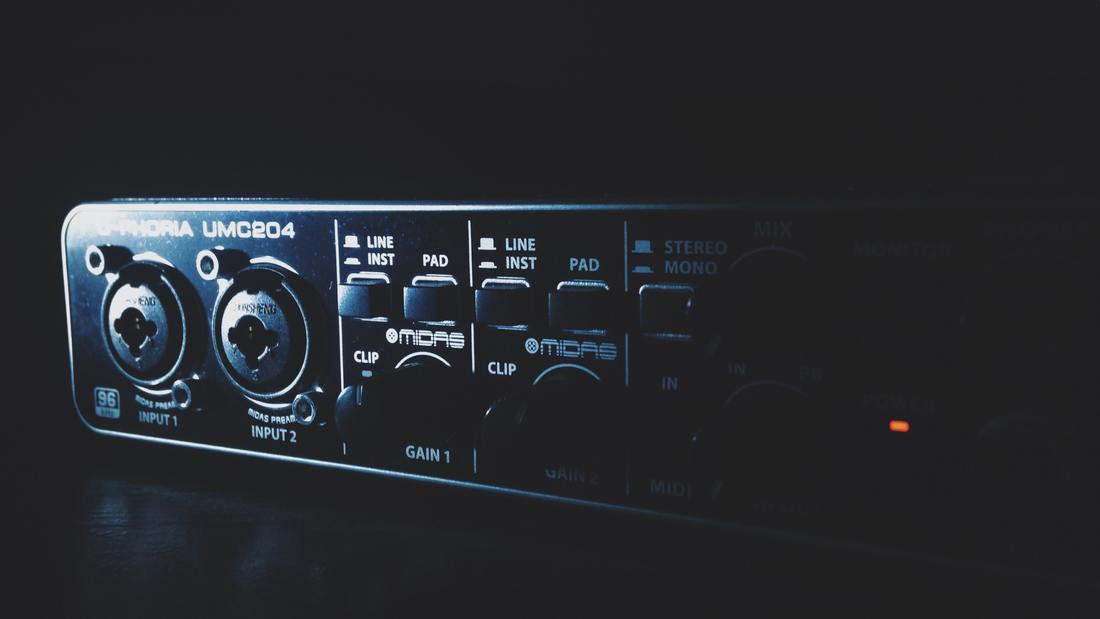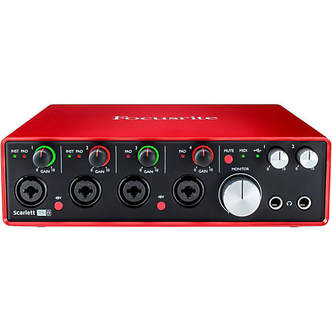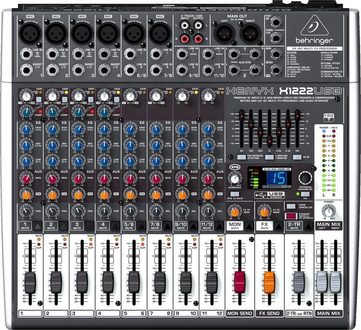|
The next piece of equipment in the recording chain, after the microphone, is the audio interface/mixer. Audio InterfacesAudio Interfaces are in simple terms, external sound cards that plug in to your computer via a USB/Firewire/Thunderbolt connection, allowing you to connect an XLR microphone to the computer to record. Why not just use the sound card that's already in your computer? Well... The Pre-Amp Audio interfaces have one or more microphone pre-amps, that will usually have hardware controls (knobs, faders and buttons) that allow you to adjust the input gain of the pre-amp to increase/decrease the loudness of the microphone's signal, a Pad switch that decreases the input level by a set amount for particularly loud signals, an Instrument/Mic impedance button (which as podcaster you don't need to worry about, just have it on the mic setting), as well as Phantom Power to power Condenser mics, and possibly Phase Invert functions to avoid phasing issues if you're recording multiple mics. The pre-amp of the audio interface will also likely be superior to the bog standard computer sound card's pre-amp. The AD/DA Converters The 'A' is for Analogue, and the 'D' is for Digital. These are circuits that translate the analogue signal produced by the microphone (frequency and amplitude information) in to 0's and 1's, determined by the Sample Rate (how often the analogue signal is measured), and the Bit Depth (how detailed the measurement is)... and back again from digital to analogue, so that you can hear it on your headphones and, or speakers. Again, the AD/DA converters of a dedicated audio interface will likely be much better (accurate) than the converters on a standard computer sound card. Audio Interfaces vs. MixersSo what's the difference? Both are audio interfaces that can connect to a computer... A Standard Audio Interface A standard audio interface, like the Focusrite Scarlett above, is fine for most situations - you can connect a mic, set the input gain level of the preamp, hit record in your recording software, and you're away... simple. This is fine if you like to apply audio processing (EQ, compression, effects...) after recording, when editing & mixing the podcast. On the other hand... A Mixer Audio Interface A mixer will usually have an EQ, Pan, and sometimes a compressor/limiter and even effects (reverb, delay... delay...) built into each pre-amp channel, or acting globally - affecting all of the channels. Any changes you make to EQ, etc, at this stage will be applied to the signal before it's recorded to the computer, so you'd better make sure the settings are right! Trying to fix the signal afterwards can be a pain :-/ A mixer is ideal for "live" situations, i.e. Radio/Streaming - if you broadcast live and are recording content to be published later as a podcast, and you need to have control over a number of microphones using the sliding faders and mute buttons - then a mixer might well be the solution. Some mixers can also act as controllers of the recording software, so you can make the changes on the mixer and the effect is applied in the software automatically. But this is only really necessary for large multi-track recordings, and not so much for podcast editing. If you do go for a Mixer, be sure to make sure it is capable of recording the number of individual channels that you want - many will combine the microphone channels into a 2 channel stereo signal before converting it to digital for the computer, so if you've 3 or more mics and you want them recorded separately, the separate signals of each channel will be combined to stereo. For example - the Behringer Xenyx 1204USB has 4 XLR mic channels, and combines the signals into a 2 channel stereo output. The Allen & Heath ZEDi-10FX also has 4 XLR mic channels, but will keep the signals separate for computer recording. TIP: If you've just two mics, then you can pan one hard Left and the other hard Right so that each is on a separate channel of the stereo signal. USb, Firewire, Thunderbolt???Don't stress! USB is more than adequate for podcasting. It comes down to how many microphones you're recording and what settings you're using for A>D conversion. If you were recording a 5-piece rock band using 24 microphones, each recording the signal digitally at 32-bit/192kHz, then Thunderbolt would be ideal, or even MADI but we don't need to go there... For podcasting, you're recording fewer mics at a lower resolution of ideally 24-bit/44.1kHz (to be explained why in another post...), so any USB 2 or USB 3 audio interface will be more than enough. Thanks for reading!
0 Comments
Your comment will be posted after it is approved.
Leave a Reply. |


